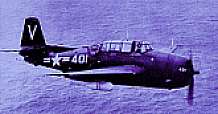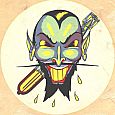
 | | Gordon Anderson
Squadron: VT-80
Ship: USS Ticonderoga
Plane: TBM/3
Medals: Air Medal | 
========================== |
| | | |  |
A World War II Veteran Remembers: Gordon Anderson
As interviewed by Elsie Saar
Mr. Gordon Anderson, 79, of Kingston, New York, was interviewed on March 30, 2004, by Elsie Saar, a volunteer at the Pittsfield branch of the National Archives and Records Administration. This is his story of his experiences in World War II.
I was born on February 23, 1925, in Syracuse, New York, one of six children. My parents were Gustave Anderson and Ethel MacIntosh. We moved a few times before settling in Hempstead, Long Island, where my father had a very good job at Gimbels as a buyer and manager. Gimbels was Macy's competitor at the time. Because of the depression my father lost his job, so we moved to Ulster County in New York where my grandmother had an extra house. My father went to work for the Works Progress Administration (WPA) as a laborer at nine dollars a week, quite a comedown from sixty-five dollars a week at Gimbels. So I suppose I would be a child of the Great Depression. After attending a one-room school in Olive Bridge, New York, where the teacher taught all subjects for eight grades, I went to high school in Kingston, New York. After graduation I lived at my grandmother's winter home in Brooklyn, and worked for an insurance company before going into the service. I wanted to enlist when I turned seventeen, but my mother made me wait a little while, so when I was almost eighteen, on February 3, 1943, I enlisted at the Naval Recruiting Station in New York City and began active service on February 18, 1943. Looking back I guess I enlisted in order to have a better chance at selecting something that I wanted to do, and maybe for some excitement also. Later the same year my brother also enlisted in the navy.
I was sent to Sampson, New York, in the Finger Lakes region of central New York for eight weeks of recruit training. Upon completion of training there, I went to the Naval Air Technical Training Center, in Memphis, Tennessee, for Aviation Radioman (ARM) school for sixteen weeks. I remember that on arrival I saw a German POW train with prisoners from the Afrika Corps. I could see some of them and recall feeling sorry for them. Many were kids like me. From there, I went to the naval air gunners' school in Hollywood, Florida, for another six weeks, training in the use of guns of the type that were used on different types of aircraft. For example, the latest model torpedo bomber had a top turret with a single .50 caliber gun and in the radioman's compartment a single .30 caliber gun with limited movement.
Then I went to air crewman school in Miami, Florida, for eight weeks where I underwent operational flight training with a number of pilots and air crews. The purpose of this training was to have people work together as a team in the various aspects of naval air combat. It included different methods in attacking targets using torpedoes or bombs. For example, to effectively attack a ship with an aerial torpedo, the rule was "low and slow". We also trained in making simulated carrier landings using the airfield for this purpose. While I was there I had the unhappy task of escorting to his home in Virginia the body of a friend who had been killed in an accident. Then I was detached to Memphis, Tennessee, for further training in radar. After I returned to Miami, I was transferred to a Carrier Aircraft Service Unit at Oceana, Virginia. There I worked on radio/radar equipment while waiting for assignment to an active squadron.
* * * * * * * * * * * * * * * * * * * * * *

Torpedo Squadron 80 (VT-80)
In May 1944, I was assigned to Torpedo Bomber Squadron 80, which was training at Oceana, Virginia, and had been formed up earlier that year. I replaced a man who had been lost in an operational training accident. There I met Art Brule, an aviation machinist mate who would be our turret gunner. Our pilot was an Ensign Hill (I don't recall his first name) who was transferred shortly after. At the end of August, Art and I met Lt. Glendon (Glen) Goodwin, a pilot who had prior combat experience (Battle of the Coral Sea and also anti-submarine warfare duty in the Atlantic) and who had previously held enlisted status as an Aviation Pilot. Glen, Art and I would spend the next seven months together, four of which were in combat.
A crew on a torpedo bomber consisted of three men-the pilot, the radioman, and the gunner. The ship proceeded on a shakedown cruise to Trinidad in the Caribbean and returned to Norfolk, Virginia. On August 30 we departed from Norfolk and headed south again, this time through the Panama Canal to San Diego, California, arriving on September 14. Four days later we left port for Pearl Harbor, Hawaii, and arrived on the 27th. The air group was based at Kaneohe Bay until October 18 when we left Pearl Harbor for Ulithi in the Caroline Islands. We anchored there with the rest of the Task Group.
On November 5, 1944, before our first mission, the chaplain spoke to us in the ready room as he would before all missions. I still remember the verses he always closed with. They are verses nine and ten from Psalms 139. Our mission on that first day was a torpedo attack on a Japanese warship in Manila Bay and our plane was hit but not severely. The next day we hit a tanker at Maraveles Harbor near Manila. On November 13 and 14 it was back to warehouses, docks, etc. on the Manila waterfront and the naval base at Cavite. On November 25 the mission was a torpedo attack on ship targets off eastern Luzon. Our plane was hit by anti-aircraft fire in the port wing. On November 26 we flew an anti-sub patrol mission. The task group then retired to Ulithi.
On December 1 we flew another anti-sub patrol mission. On December 16 we struck the airfield at Laoag in the northern part of Luzon. The last flight in December was a search mission on the 21st.
On January 3, 1945, we attacked airfields on Formosa (now Taiwan) and on the 7th we hit Laoag again. Then it was back to Clark Field in Luzon. On the 9th the air group destroyed a large aluminum plant on Formosa. On January 12 the squadron made a torpedo attack on a Japanese convoy near Cam Rahn Bay off the coast of French Indochina (currently Viet Nam). Our torpedo hit one of the ships. The air group sank or burned all the ships that day. On January 16, 1945, we attacked targets at Yulin Harbor on the island of Hainan off the Chinese coast, and the plane was severely damaged. We considered ourselves lucky to get back from that one.
* * * * * * * * * * * * * * * * * * * * * *
Divine Wind
On January 21, 1945, the Ticonderoga was hit by a couple of kamikaze ("divine wind") pilots and put out of action. The ship was able to get back under reduced steam to the Ulithi anchorage where it was sent back to the states for extensive repair. Air Group 80 was then transferred to the USS Hancock.
On October 20-23, 1994, I attended the reunion of Air Group 80 that was held in Pensacola, Florida. This was about 50 years after our first missions. Unfortunately I was not able to locate either Glen Goodwin or Joe Beery before the reunion. However I still keep in touch with my gunner, Art Brule, who lives in Turner's Falls, Massachusetts.
Because of my time in the service I am entitled to the following: Aircrew insignia with three stars, Air Medal, American Campaign Ribbon, Asiatic-Pacific Campaign Ribbon with four battle stars, Philippine Liberation Campaign Ribbon with two battle stars, Navy Unit Commendation Ribbon, Good Conduct Medal, Victory Medal WWII, National Defense Medal (Korean War), and the New York State Conspicuous Service Cross.
Mr. Gordon Anderson, 79, of Kingston, New York, was interviewed on March 30, 2004, by Elsie Saar, a volunteer at the Pittsfield branch of the National Archives and Records Administration. This is his story of his experiences in World War II.
~ Copyright -2006- CV14@graffiti.net ~
text written by Elsie Saar |